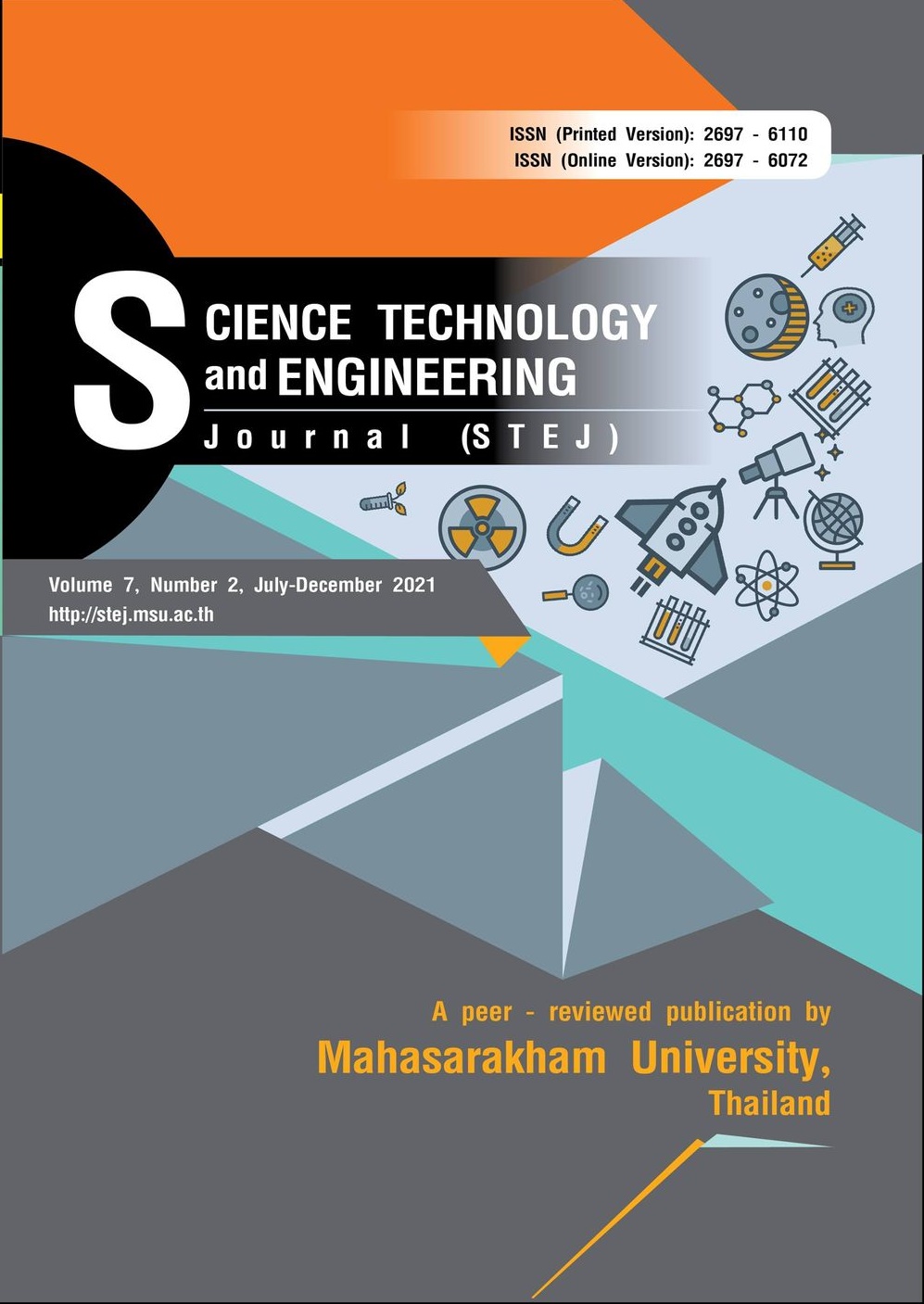Physical Properties of Banana Leaf-Patterned Fabric Made of Weft Yarns of Cotton, Blended with Banana Fibers and Eri Silk for Value-Added Use of Banana Trees
Keywords:
banana fiber, banana yarn, eri silk, physical properties, banana leaf patternAbstract
This research aimed to study physical properties of banana leaf-patterned fabric made of number 20 Ne and 3 Ne natural yarns prepared from cotton, banana fibers and Eri silk with the designated ratio of 80:10:10. The experimental yarns were used as weft for the designated woven fabric, in which the fabric pattern was designed to represent leaf pattern on banana leaves referring to organic origin and unique characteristics of nature ; the parallel lines symbolizing the distinctive texture of banana leaves were created by yarns of different sizes. Upon testing the physical properties of the woven fabric, this research showed that the banana leaf-patterned fabric made of yarns from cotton, blended with banana fibers and Eri silk has quite less thread count in both warp and weft per square inch. Due to large size of the yarn, the fabric structure has moderately open spaces between yarns, allowing exceptionally good flow of air. Also, the fabric is proved to be strong and have high tensile strength in both warp and weft floats and the dimensional change in the shrink after washing and drying was less than that of the warp yarn.References
Amaranonta, M. (1999). Folk Handicraft. Institute of Culture and Arts Journal Srinakharinwirot University, 2(2), 64-84.
Anonymous. (2004). Fiber and fabric properties. Ingeo Worldwide Offices.
Anunvrapong, A., Noodang, P., Satsan, R., Krongpetch, N., & Kongsrichai N. (2016). The Product Development on Woven Goods Produced from Nipa Palm Fruit Clusters. UTK Research Journal, 10 (2), 115-122.
Atthathom, T., Phromma, N., Sirimungkararat, S. & Patanasethanon, W. (2002). Analysis on Organic Homegrown Eri Silk’s Production Cost for Further Industrial Market. http://elibrary.trf.or.th/project_content.asp?PJID=RDG5220019.
Bunpanya, J. (2010). Influence of temperature and humidity on hot air on drying kinetics of banana [Unpublished Master dissertation]. Chiang Mai University.
Chanthawongsa, N. (2010). Development of Saccharification of Durian Peels and Banana Peels for Ethanol Fermentation [Unpublished Master dissertation]. King Mongkut’s University of Technology Thonburi.
Chunbubpha, D. (2010). The Study of Optimal Condition of Hydrolysis of Banana Peel (Musa sapientum Linn.) [Master of Engineering]. Kasetsart University.
Jangsawang, A. (2012). Effect of Benzyladennine (BA) on Increasing Sprouting Count of Musa sapientum Linn Banana by Tissue Culture Method [Master of Science in Education Program in Teaching Science]. Chiang Rai Rajabhat University.
Jarawa, A. (2007). Development of Edible Film ‘Kluai Nam-Wa’ Musa (ABB group) [Master’s dissertation, (Packaging Technology)], Kasetsart University.https://doi.nrct.go.th/ListDoi/listDetail?Resolve_DOI=10.14457/KU.the.2007.122
Khumhan, M., Suwanphom, N. & Narangsak, P. (2016). Design, Crafting Furniture from Banana Tree Fibers. Art and ArchitectureJournal Naresuan University, 7(2), 39-54.
Lecturer of Textile and Garments. (2019, July 9), RMUTT developed banana fibers for apparel and home textiles. Loetanarak, S. (2015). Study on property of lumbering from banana fiber trees as guidelines for product design[Master dissertation], Silpakorn University]. http://ithesis-ir.su.ac.th/ dspace/handle/123456789/644.
Manantee, S. (2009). Pisang awak (Musa sapientum Linn.) Processing Business in Amphoe Sangkhom, Changwat Nongkhai [Unpublished Master dissertation]. Khon Kaen University.
Nonthong, O. (2010). The study of the Efficiency of Natural Resin From Banana (Musa Sapientum Linn) Branch for Chromium Removal in Wastewater from Chromium Cloating Industry banana [Unpublished Master dissertation]. Nakhon Ratchasima Rajabhat University.
Polsri, S. (2004). Theory and principles of community development.
Poungngamchuen, J. & Sakkatat, P. (2011, January 27-29). Community Leaders’ Potential Development in the Community Development Sector of Cherng Doi Sub-district, Doi Saket District, Chiang Mai Province. The International Conference on Sustainable Community Development, (pp.101-105).https://cscd.kku.ac.th/uploads/proceeding/070911_163320.pdf
Ritthison, S. (2012). Biopulping from banana pseudo-stem of Num-Wa by Trichodermaviride. Warasan Witthayasat Mokho.
Sannamwong, K., Rawinu, B., Noppasenee, P., Petchwichit, P., Sukrittanon,Y., Itrat, R., Raksang,V., Wilai, S., Junlaphun, S. & Sutthana, S. (2006). Research and Development Project on Eri Silkworm in the Northeast of Thailand. Department of Agriculture.
Sinha, M.K., & Ghosk, S.K. (1978). Annual report of jute technological res.laboratories. Calcutta,14.
Sirimungkararat, S. (2019, June 18). Eri silk keeping an eye on Economics insects (online).https://www.stou.ac.th/study/sumrit/10-58/page2-10-58.html
Soiraya, B. (2009, May 20). From Banana Yarns to ‘Banana Yarn-based Cloth’...Cool When Worn. Daily News Online. http://lib3.dss.go.th/ fulltext/techno_file/CF64/CF64 (C5).pdf
Sopitphapa, P. (2010). The Modification of Musa (ABB) sp. ‘Kluai Namwa’ (banana) Flour and Starch by Pregelatinizing [Master dissertation].Kasetsart University. https://doi.nrct.go.th/ListDoi/listDetail?Resolve_DOI=10.14457/KU.the. 2010 94
Sukonthamanee, P. (2019). Mural to Ikat Textile Art Humanities, Arts and Social Sciences Studies, 432-451.
Suttipong, S. (2020). Development of the Processes for Nutrition Addition for Making Sheet Dried Banana[Unpublished Master dissertation]. Kasetsart University.
Thamee, T. & Rattanapitigorn, P. (2011). Types of solvent, extraction conditions and properties of oil from Eri-silk pupa (Samia ricini). Warasan Kaset.
Udomkun, P., & Innawong, B. (2018). Effect of pre-treatment processes on physicochemical aspects of vacuum-friedbanan chips. Journal of Food Processing and Preservation, 42 (8), e13687.
Wiwatchaimanee, K. (2011). Production of Corrugated Liner from Musa sapientum Linn Banana Pulp and Recycled kraft Pulp [Unpublished Master dissertation]. King Mongkut’s University of Technology Thonburi.
Yongyuth, C. (2009). Nature-based Furniture Walls made of Banana Fibers: Building Innovation Program. [Independent Study]. Kasetsart University.
Downloads
Published
How to Cite
Issue
Section
License
Copyright (c) 2021 Science Technology and Engineering Journal (STEJ)

This work is licensed under a Creative Commons Attribution-NoDerivatives 4.0 International License.








